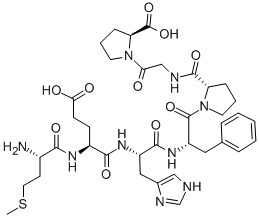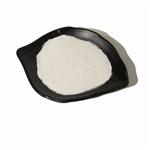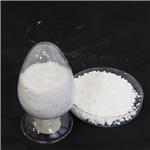Semax: Development, Neuroprotective Effects, and Mechanistic Studies
Aug 25,2025
Semax is a synthetic peptide that was first developed by Russian researchers in the 1980s. It is authorized in Russia and Ukraine for indications including ischemic brain stroke, encephalopathy, optic nerve atrophy, and cognitive disorders such as dementia.Research suggests that Semax may offer potential benefits to patients suffering from a variety of neurological conditions, including Alzheimer's, traumatic brain injury (TBI), and stroke. Semax is an analog of the ACTH(4-10) peptide, the latter a fragment of adrenocorticotropic hormone (ACTH). ACTH is a hormone that plays a key role in cortisol production in the body.

Effect of Semax in a Rat Model of Cerebral Ischemia–Reperfusion
For many years, ischemic stroke has been one of the main causes of mortality and disability among the populations of many developed countries. The search for new therapeutic strategies for stroke treatment remains an urgent problem. The synthetic peptide Semax is a hybrid molecule; its N-terminus contains a fragment of ACTH (4–7)-Met-Glu-His-Phe, which coincides with a similar site of α-MSH, whereas its C-terminus is stabilized by the addition of the biogenic tripeptide Pro-Gly-Pro, which affords greater metabolic stability. The study of the molecular mechanisms underlying the actions of Semax using models of cerebral ischemia in rats showed that the peptide acts on the brain transcriptome: it enhances the transcription of neurotrophins and their receptors, significantly affects the expression of genes associated with the processes of the immune response, suppresses the activation of the expression of genes involved in inflammation, and prevents the decrease in the expression of genes associated with neurotransmission. The peptide drug Semax has a pronounced neuroprotective effect in the treatment of cerebrovascular insufficiency and acute cerebral stroke. However, the molecular mechanism underlying the action of this peptide has not been established and is being actively investigated.[1]
It can be assumed that, in the subcortical structures of the brain, the manifestation of the protective effect of Semax occurs via changes in the levels of pJNK and pCREB under the action of the peptide. In turn, the role of pJNK and pCREB under the action of Semax may be associated with their participation in the modulation of neurotransmission and inflammation signaling pathway activity in subcortical structures. We showed that pJNK was upregulated in this region of the brain during ischemia, followed by its downregulation after the administration of Semax; in contrast, pCREB was downregulated during ischemia and upregulated under the effect of Semax. Thus, the activity of pJNK and pCREB may be an important element in the mechanism underlying the neuroprotective action of Semax, including explaining the multiple compensatory effects of the peptide in the zone of damage after ischemia–reperfusion. In the subcortex, it inhibited pJNK and activated pCREB without affecting the level of MMP-9 and c-Fos; however, in the cortex (which contained the area adjacent to the ischemic core), it downregulated pJNK, MMP-9. Nevertheless, the general effect of the drug on both brain tissues occurred via its ability to compensate for the expression profiles of these proteins, which were disturbed by ischemia.
Semax Affects Copper-Induced Abeta Aggregation and Amyloid Formation
It was proposed that an abnormally high concentration of Aβ could result in aggregation into a β-sheet rich structure, the starting point of the fibrillogenesis of Aβ. Heptapeptide ACTH(4–7)-PGP, also known as Semax (Met-Glu-His-Phe-Pro-Gly-Pro), is an ACTH-like peptide, in particular an analog of the endogenous regulatory peptide ACTH (4–10) (Met-Glu-His-Phe-Arg-Trp-Gly); biological effect studies on Semax showed that this peptide has pronounced nootropic, neuroprotective, and neurotrophic properties, stimulating learning and memory formation in rodents and humans. To date, there is a lack of information about the ability of this peptide to inhibit or hamper Aβ fibril formation. Here, we performed a combination of biophysical and biological experiments to test the ability of Semax to modulate fiber formation in both the presence and absence of Cu2+ and model membranes. We found that Semax is able, in a concentration-dependent way, to inhibit fiber formation both in the buffer and in the presence of model membranes. The results suggest that it could modulate the Aβ fiber formation process. Although more in-depth details are needed, this first study about the anti-aggregating properties of Semax provides promising results and could represent the starting point for a complete evaluation of Semax as an anti-AD drug candidate.[2]
Semax at an equimolar ratio does not significantly perturb any of the kinetic parameters of the Aβ1–40 fibrillogenesis process in our condition. Interestingly, the increase of the Semax amount to a ratio of 1:5 leads to higher tlag and t1/2 . In summary, we performed a series of biophysical experiments that show that the heptapeptide ACTH(4–7)-PGP is able to inhibit, in the absence of the model membrane, Aβ fiber formation. In particular, we showed that in the presence of Cu2+ ions, Semax is able not only to sequester metal ions, inhibiting Aβ:Cu2+ complex formation, but also to interact, most probably, with Aβ:Cu2+ oligomers, retarding the formation of protofibrillar and fibrillar species. DSC results showed that the heptapeptide modulates the interaction of Aβ:Cu2+ with the hydrophobic core of the model membrane, preventing or retarding the insertion of prefibrillar species in the hydrophobic core of the model membrane. Finally, the MTT assay revealed that Semax or the Semax:Cu2+ complex protects cells from the toxicity of Aβ1–42 oligomers. More in-depth experiments should be done especially to investigate the effect of it on ROS production, which is known to increase as an effect of Aβ:Cu2+ interaction.
Semax Peptide at the Transcriptome Level
Focal cerebral ischaemia or stroke is one of the leading causes of mortality and disability in developed countries. The development of effective strategies to treat ischaemic stroke is an important issue in modern medicine and pharmacology. A drug currently found to be efficient in cerebral stroke therapy is a synthetic neuroprotective peptide called Semax (Met-Glu-His-Phe-Pro-Gly-Pro). In experimental models of cerebral ischaemia Semax administration led to the recovery of the animals’ ability to learn in a Morris water maze and passive-avoidance task. A clinical study has shown the efficacy of Semax in the treatment of patients with ischaemic stroke. The peptide improves functional recovery and motor performance. Nevertheless, the molecular mechanisms of its neuroprotective effects remain unclear. This study allowed us to observe alterations to the transcriptome profile and to reveal previously unknown compensation effects of Semax on the biological processes and signal pathways, which apparently provides the neuroprotective effects of the peptide in ischaemia–reperfusion (IR) conditions.[3]
Drugs, based on native regulatory peptides, are used to treat various pathological conditions, including peptide drugs that help restore brain function after acute cerebrovascular accidents. In studies to investigate the molecular mechanisms of action of such neuroprotective peptides, experimental models of ischaemia in animals are of great importance. In conclusion, the study of the transcriptome profile of cells in the subcortical structures of the brain with administration of the neuropeptide drug Semax under tMCAO conditions led to the identification of DEGs that encode proteins that participate in various functional categories, biological processes and signalling pathways, via which brain cells form a response to ischaemia–reperfusion. An important feature of the neuroprotective action of Semax is the normalization of mRNA expression patterns that are disrupted during IR conditions, particularly those associated with anti-inflammatory processes and activation of neurotransmitter systems.
References
[1]Sudarkina OY, Filippenkov IB, Stavchansky VV, Denisova AE, Yuzhakov VV, Sevan'kaeva LE, Valieva LV, Remizova JA, Dmitrieva VG, Gubsky LV, Myasoedov NF, Limborska SA, Dergunova LV. Brain Protein Expression Profile Confirms the Protective Effect of the ACTH(4-7)PGP Peptide (Semax) in a Rat Model of Cerebral Ischemia-Reperfusion. Int J Mol Sci. 2021 Jun 8;22(12):6179. doi: 10.3390/ijms22126179. PMID: 34201112; PMCID: PMC8226508.
[2]Sciacca MFM, Naletova I, Giuffrida ML, Attanasio F. Semax, a Synthetic Regulatory Peptide, Affects Copper-Induced Abeta Aggregation and Amyloid Formation in Artificial Membrane Models. ACS Chem Neurosci. 2022 Feb 16;13(4):486-496. doi: 10.1021/acschemneuro.1c00707. Epub 2022 Jan 26. PMID: 35080861; PMCID: PMC8855339.
[3]Filippenkov IB, Stavchansky VV, Denisova AE, Yuzhakov VV, Sevan'kaeva LE, Sudarkina OY, Dmitrieva VG, Gubsky LV, Myasoedov NF, Limborska SA, Dergunova LV. Novel Insights into the Protective Properties of ACTH(4-7)PGP (Semax) Peptide at the Transcriptome Level Following Cerebral Ischaemia-Reperfusion in Rats. Genes (Basel). 2020 Jun 22;11(6):681. doi: 10.3390/genes11060681. PMID: 32580520; PMCID: PMC7350263.
- Related articles
- Related Qustion
- Can Semax be used to treat patients during pregnancy? Dec 16, 2024
Due to the lack of adequate research on its safety in these populations, Semax is not recommended for use in pregnant and breastfeeding women.
Supplementation with pyridoxal 5'-phosphate monohydrate can synthesize neurotransmitters such as dopamine and serotonin, maintaining a healthy nervous system.....
Nov 4,2025Biochemical EngineeringEthyl linoleate has supporting applications in skin care and inflammation control.....
Aug 26,2025API








